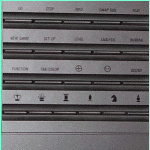ABOUT SAITEK KASPAROV PRISMA MODEL 281 ELECTRONIC CHESS COMPUTER
Luxury Table-top model with built-in LCD chessboard; express take-back and replay features; LCD info display; powerful 32K program; 64 playing levels.
Your Kasparov Prisma chess computer is one of the most advanced and sophisticated chess computers on the world market today. Whether you use Prisma as an opponent or a teacher, you will be amazed at all of its capabilities and functions! This computer's ultra-modern look and feel, its built-in LCD chessboard, and its exciting array of special features all make it stand out among its competitors.
SAITEK KASPAROV PRISMA MODEL 281 GAME CHARACTERISTICS
Prisma’s strong 32K program knows all the rules of chess, and its tremendous range of 64 different playing levels accommodates any type of chess player, from beginner to chess master. Those who are just learning to play can appreciate Kasparov Prisma’ valuable coaching features, such as move suggestions and the ability to take back up to 50 moves. All players benefit from features such as the the display of extensive move evaluation information, the ability to replay the last 50 moves of a game, and the accurate chess clock which keeps time for both sides.
This versatile chess computer also solves problems up to mate in 16, and stores the current position in is memory for up to two full years. It has an opening library with a build-in transposition detector, and its Self-Play function allows you to sit back and watch as it plays against itself. Or, if you and a fried would like to play against one another, Prisma also acts as a referee, by simply allowing you to use its board while it quietly stays in the background, making sure all moves are legal, and keeping track of move times.
All in all, you can be certain that you have acquired a wonderful opponent and partner in Kasparov Prisma. This chess computer will provide you with a great number of exciting and entertaining chess games for many years to come.
Excerpts taken from the SAITEK KASPAROV PRISMA user manual and box.

Technical Specification
Saitek Kasparov Prisma (1990)



Box
Control Buttons
User Manual
Spacious Mind
Schachcomputer.Info
Active 2017
Tourn. 2015
1779
-
T1
T2
T3
T4
T5
Final
2382
2087
2403
2089
2250
2233
MANUFACTURER
PROGRAMMER
Saitek Industries
Julio Kaplan
2150 USCF
1990
$249,00
1735 SSDF
Year:
MFR ELO:
Original Price:
Wiki ELO:
Model #:
281
My Serial #:
T0320784
Processor OEM
Hitachi
Processor:
H8
Speed:
Type:
8 Bit
10 MHz
ROM:
32 KB
RAM:
1 KB
Battery Type:
6 x C Cell
Power Adapter:
9V DC +/- 300 mA
Display:
LCD Chess Board
Board Type:
Press Sensory
Overall Size:
Board Size:
8 x 8 in
16.3/8x11x1.1/4
Options Select:
Button Select
Play Levels:
64
Opening Book:
17K Half moves
Take Back:
50 Half Moves
Position Setup:
Available
Position Verify:
Available
Move Analysis:
Display Info:
Available
Available
Solve Mate:
Mate-in-8
Save Game:
Available
Ponder:
Available
Search Depth:
16 Ply Max.
Provide Hint:
Available
Teach Mode:
Not Available
Change Sides:
Available
Active Level:
TM Level:
B2
Infinite Level:
B7
A5
Game Features
Matchplay & Test ELO Ratings
Computer Game Rating
Rating Test
Other Computer Chess Ratings
USCF
USCF
Spacious Mind
Human Rating
USCF
CCR 95
CCNS 95
Ply 95
FIDE
USCF
1921
1894
1918
1851
1865
Class A Level Electronic Table Top Chess Computer!
Hardware Specification

